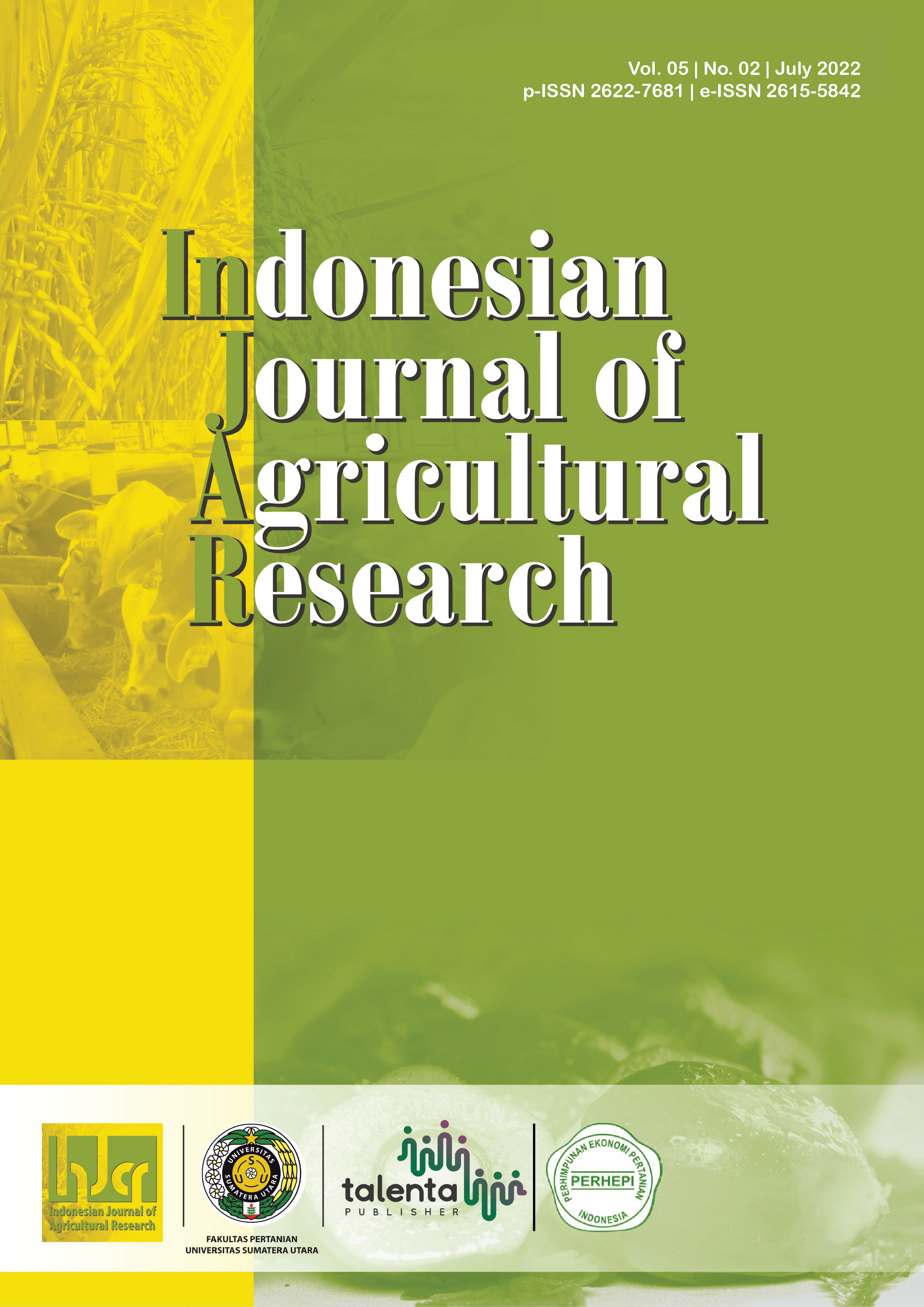Descriptive and Vegetative Characterization of fifteen ecotypes of Snake Gourd (Trichosanthes cucumerina L.) in Nigeria
DOI:
https://doi.org/10.32734/injar.v5i2.9008Keywords:
descriptive characters, fifteen ecotypes, Trichosanthes cucumrina, vegetativeAbstract
The descriptive and vegetative characterization of fifteen ecotypes of Trichosanthes cucumerina L (snake gourd) in Nigeria was carried out. The field study was done in two locations Markurdi and Umudike to evaluate the descriptive and vegetative characters of fifteen ecotypes of T. cucumerina from Middle Belt of the country, the South-South, South Eastern part and South Western part of Nigeria. Randomized Completed Block Design was adopted for the experiment at the exploration farm of Michael Okpara University of Agriculture, Umudike and Federal University of Agriculture, Makurd at the same growing season. Descriptive and vegetative analysis was done using Minitab 16. The qualitative vegetative characteristic of snake gourd accessions vigour levels ranged from low, moderate and high. Leaf colour was from deep/pale/light green, stem colour was light, pale and deep green. The mean of the vegetative characters ranged from 2.7660-1575 ±0.48-99; cumulative variation percentage 7.65-64.75;. The germination percentage of all the accessions was significant (p<0.05). CRS – IKM (100+00), Osu – OSH – 2 (91.67±4.82).EKT – OYE was higher than Ben-MKDI (58.36±8.34). The plant height among the accessions was not significant, block was significant (P≤0.05). Leaf sizes (cm) of all the accessions were not significant (P>0.05), while main vine length (cm) at 5% probability was not significant and their treatment interaction was insignificant (P>0.05). The main vein length was highest in ABI-UKW with 636.0±164.0, followed by EKI-OYE 514.0±84.3 and least from RIV-ELE 275.7±26.4. The fruit colour at ninety days (90) of ten (10) accessions of snake guard was orange green or strip orange green and remaining accessions was milky green or light green. The fruit shape was long, thick and cylindrical. The seed colour was speckled russet.
Downloads
References
E. Toensmeier, R. Ferguson, and M. Mehra, “Perennial vegetables: A neglected resource for biodiversity, carbon sequestration, and nutrition,†PLoS One, vol. 15, no. 7, Jul. 2020, doi: 10.1371/journal.pone.0234611.
A. M. D. Uwumarongie et al., “Influence of rubber effluent and NPK fertilizer on the performance and fruit quality of snake tomato (Trichosanthes cucumerina L. Haines) in a three and four years old (an existing) rubber plantation,†Int. J. Plant Soil Sci., pp. 164–176, Sep. 2022, doi: 10.9734/ijpss/2022/v34i2331576.
C. Ekeke and J. U. Agogbua, “Morphological and anatomical studies on trichosanthes Cucumerina L. (Cucurbitaceae),†Int. J. Plant Soil Sci., vol. 25, no. 6, pp. 1–8, Dec. 2018, doi: 10.9734/ijpss/2018/44982.
A. Rolnik and B. Olas, “Vegetables from the Cucurbitaceae family and their products: Positive effect on human health,†Nutrition, vol. 78, p. 110788, Oct. 2020, doi: 10.1016/j.nut.2020.110788.
P. Kumar, P. S. Khapte, and P. R. Meghwal, “Genetic Diversity of Vegetables in Arid Region,†in Horticulture Based Integrated Farming Systems, Taylor and Francis, 2021, pp. 35–53.
G. Chomicki, H. Schaefer, and S. S. Renner, “Origin and domestication of Cucurbitaceae crops: insights from phylogenies, genomics and archaeology,†New Phytol., vol. 226, no. 5, pp. 1240–1255, Jun. 2020, doi: 10.1111/nph.16015.
N. P. S. Dhillon et al., “Sustainable cucurbit breeding and production in Asia using public-private partnerships by the world vegetable center,†Agronomy, vol. 10, no. 8, p. 1171, Aug. 2020, doi: 10.3390/agronomy10081171.
E. Barcanu, O. Agapie, I. Gherase, and B. Tănase, “Trichosanthes Cucumerina L . A new species acclimatized and bred in Romania,†vol. LXV, no. 1, 2021.
L. K. Bharathi, T. K. Behera, A. K. Sureja, K. J. John, and T. C. Wehner, “Snake gourd and pointed gourd: Botany and horticulture,†in Horticultural Reviews, vol. 41, Hoboken, New Jersey: John Wiley & Sons, Inc., 2013, pp. 457–495.
A. N. Osuagwu, C. U. Aguoru, L. O. Omoigui, and J. O. Olasan, “Karyological studies and chromosomal analysis of fifteen accessions of Trichosanthes cucumerina L. (snake gourd),†Jun. 2022.
Z. Hu and L. Zhao, “Research progress of Triterpenoid secondary metabolites in Cucurbitaceae plants,†vol. 8, p. 2019, 2019.
N. D. Devi, S. Mariappan, T. Arumugam, and C. R. Anandakumar, “Genetic variability, heritability, correlation and path analysis in snake gourd (Trichosanthes cucumerina L.),†Electron. J. Plant Breed., vol. 8, no. 2, pp. 566–571, Jul. 2017, doi: 10.5958/0975-928X.2017.00085.0.
ECHO, “Snake Gourd: Plant Information Sheet,†no. 239. ECHO, p. 33917, 2022.
R. O. Aderibigbe, F. O. Adeboyejo, M. Oluwakemi, J. K. Korese, and S. K. Chikpahd, “Comparative nutritional analysis of paste developed from Tricosanthes Cucumerina Linn and Lycopersicon Esculentum L. Mill. in Nigeria,†in Tropentag 2019: Filling gaps and removing traps for sustainable resources management, 2019, no. October.
P. K. Mukherjee et al., “Therapeutic importance of Cucurbitaceae: A medicinally important family,†Journal of Ethnopharmacology, vol. 282. Elsevier Ireland Ltd, p. 114599, Jan. 10, 2022, doi: 10.1016/j.jep.2021.114599.
Amitesh Ashok Bobade, Chinmay Vinay Thatte, and Rutuja Babanrao Tijare, “Trichosanthes cucumerina: A perspective on various medicinal uses or activities,†GSC Biol. Pharm. Sci., vol. 20, no. 03, pp. 141–147, 2022, doi: 10.30574/gscbps.2022.20.3.0350.
J. Merheb et al., “Characterization of Lebanese Germplasm of Snake Melon (Cucumis melo subsp. melo var. flexuosus) Using Morphological Traits and SSR Markers,†Agronomy, vol. 10, no. 9, p. 1293, Sep. 2020, doi: 10.3390/agronomy10091293.
C. Jeffrey, “Further notes on Cucurbitaceae: V*. the Cucurbitaceae of the Indian Subcontinent,†Kew Bull., vol. 34, no. 4, p. 789, 1980, doi: 10.2307/4119071.
K. Pradheep, D. R. Pani, and K. C. Bhatt, “Taxonomic Notes on the Trichosanthes cucumerina Group (Cucurbitaceae) from India,†Novon, vol. 24, no. 1, pp. 39–45, 2015, doi: 10.3417/2013024.
T. Stoilova and G. Pereira, “Assessment of the genetic diversity in a germplasm collection of cowpea (Vigna unguiculata (L.) Walp.) using morphological traits,†African J. Agric. Res., vol. 8, no. 2, pp. 208–215, 2013, doi: 10.5897/AJAR12.1633.
F. Goodarzi, R. Darvishzadeh, A. Hassani, and A. Hassanzaeh, “Study on genetic variation in Iranian castor bean (Ricinus communis L.) accessions using multivariate statistical techniques,†J. Med. Plant Res., vol. 5, no. 21, pp. 5254–5261, Oct. 2011, doi: 10.5897/jmpr11.664.
M. Nyasulu, A. Sefasi, S. Chimzinga, and M. Maliro, “Agromophological characterisation of amaranth accessions from Malawi,†Am. J. Plant Sci., vol. 12, no. 10, pp. 1528–1542, Oct. 2021, doi: 10.4236/ajps.2021.1210108.
Downloads
Published
How to Cite
Issue
Section
License
Copyright (c) 2023 Indonesian Journal of Agricultural Research

This work is licensed under a Creative Commons Attribution-ShareAlike 4.0 International License.



















